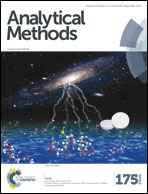Rotation mixing-assisted liquid–liquid microextraction: a new microextraction approach for the determination of priority phenols in water samples
Abstract
In this study, a new sample pretreatment method termed as rotation mixing-assisted liquid–liquid microextraction combined with liquid chromatography with ultraviolet detection was developed for the determination of selected priority phenols in water samples. In this approach, a binary solvent system of water sample and low-density extraction solvent (1-dodecanol) was mixed at 80 rpm for 8 min with a circular rotation in the absence of a disperser solvent. Fine organic droplets were formed during continuous end-over-end action, which accelerated mass transfer of the analytes to the organic phase. After extraction, phase separation was performed by centrifugation and the enriched analytes in the floated extractant phase were determined. A series of parameters that influence extraction were investigated systematically. Under the optimized conditions, the enrichment factors and extraction recoveries ranged from 61 to 138 and 37 to 83%, respectively, that were comparable with those obtained by other mechanical methodologies, i.e., vortex agitation, magnetic stirring and ultrasonic treatment. The limits of detection were 0.29–0.63 ng mL−1. Relative standard deviations were less than 5.3% for intra-day and 8.3% for inter-day precision. This method has been also successfully applied to analyze real water samples at two different spiked concentrations and satisfactory recoveries were achieved.


 Please wait while we load your content...
Please wait while we load your content...